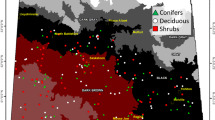Abstract
The Government of Canada’s farm assistance programs have affected >80 % of Canada’s agricultural land base. One important program in the Prairie Provinces was the prairie shelterbelt program (PSP). A significant aspect of the PSP was shelterbelt tree planting to protect farmyard infrastructure and reduce soil erosion. The main goal of this paper was to map historical shelterbelt establishment, total expected shelterbelt length, and total expected number of six common planted shelterbelt species: caragana (Caragana arborescens), green ash (Fraxinus pennsylvanica), Manitoba maple (Acer negundo), Scots pine (Pinus sylvestris), white spruce (Picea glauca Monch), and hybrid poplar (Populus spp.). A clustering approach was designed to group all agricultural ecodistricts (106 total) into clusters (31 total) based on their similarity in 42 variables within five soil zones of Saskatchewan. Correlations between trees ordered through the PSP and observed shelterbelt length (across 2.1 Mha cumulative study area) were used for shelterbelt probability mapping. Mapping accuracy of planted shelterbelts was 48–86 %. Total shelterbelt length (of any species) ranged from 322 to 45,231 km for (in descending order) dark brown > brown > black > dark gray > gray soil zones. Novel decadal time-lapse maps and species-specific shelterbelt maps were produced to capture the progression of shelterbelt establishment for the first time at a province-wide scale which gave a new perspective, in map format, of the expansive impact of the living legacy of the PSP. Shelterbelt data gaps and high priority clusters of agricultural land in Saskatchewan were identified for future shelterbelt research.






Similar content being viewed by others
References
Amichev BY, Kurz WA, Smyth C, Van Rees KCJ (2012) The carbon implications of large-scale afforestation of agriculturally marginal land with short-rotation willow in Saskatchewan. Glob Change Biol Bioen 4(1):70–87
Czerepowicz L, Case BS, Doscher C (2012) Using satellite image data to estimate aboveground shelterbelt carbon stocks across an agricultural landscape. Agric Ecosyst Environ 156:142–150
ESRI. (2010) ArcMap–ArcInfo system for Windows. Release 10.0. ESRI, Redlands, CA
Kort J, Turnock R (1999) Carbon reservoir and biomass in Canadian prairie shelterbelts. Agrofor Syst 44:175–186
Kulshreshtha S, Van Rees K, Hesseln H, Johnston M, Kort J (2011) Issues in agroforestry development on the Canadian Prairies. In: Kellimore L (ed) Handbook on Agroforestry: management practices and environmental impact. Nova Science Publishers, New York, pp 91–127
Marshall IB, Schut P, Ballard M. (1999) A National Ecological Framework for Canada: Attribute Data. Environmental Quality Branch, Ecosystems Science Directorate, Environment Canada and Research Branch, Agriculture and Agri-Food Canada, Ottawa/Hull, http://www.sis.agr.gc.ca/cansis/nsdb/ecostrat/index.html. Accessed 10 Feb 2014
Pankiw J, Piwowar J (2010) Seasonality of imagery: the impact on object-based classification accuracy of shelterbelts. Prairie Perspect: Geogr Essays 13:39–48
SAS Institute. (2013) SAS software, Version 9.2: SAS Documentation. SAS Institute Inc., Cary, NC, USA
Saskatchewan geospatial imagery collaborative (SGIC). (2013) Geospatial imagery access system. www.flysask.ca. Accessed 10 Feb 2014
Short NM. (2008) The Remote sensing tutorial: Collecting data at the surface: ground truth (section 13). Federation of American Scientists (FAS), Washington, DC, U.S.A. https://www.fas.org/irp/imint/docs/rst/Sect13/Sect13_3.html. Accessed 10 Feb 2014
Soil Landscapes of Canada Working Group (SLC). (2010) Soil Landscapes of Canada v3.2 (digital map and database at 1:1 million scale). Agriculture and Agri-Food Canada. http://www.sis.agr.gc.ca/cansis/nsdb/slc/v3.2/index.html. Accessed 10 Feb 2014
Wiseman G, Kort J, Walker D (2009) Quantification of shelterbelt characteristics using high-resolution imagery. Agric Ecosyst Environ 131:111–117
Acknowledgments
Funding was provided by Agriculture and Agri-Food Canada (AAFC)’s Agricultural Greenhouse Gases Program (AGGP). We thank the AAFC Agroforestry Development Centre at Indian Head, SK for providing the shelterbelt tree data. We are grateful to P. Krug of AAFC, N. Nicolichuk (retired) of the Saskatchewan Research Council for digitizing shelterbelts, D. Jackson, S. Poppy, J. Rempel of the University of Saskatchewan, and a number of devoted summer students for doing the field work and conducting landowner surveys.
Author information
Authors and Affiliations
Corresponding author
Rights and permissions
About this article
Cite this article
Amichev, B.Y., Bentham, M.J., Cerkowniak, D. et al. Mapping and quantification of planted tree and shrub shelterbelts in Saskatchewan, Canada. Agroforest Syst 89, 49–65 (2015). https://doi.org/10.1007/s10457-014-9741-2
Received:
Accepted:
Published:
Issue Date:
DOI: https://doi.org/10.1007/s10457-014-9741-2




